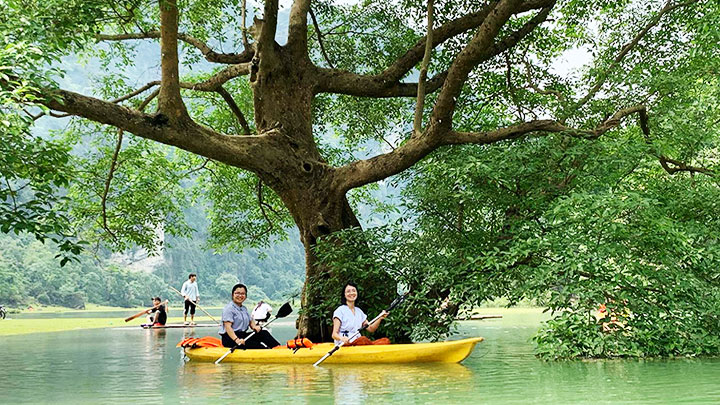 |
| The overview of Dong Lam |
Visitors to the destination are often startled by its romantic scenery.
1. Local people in Huu Lien call Dong Lam the land of rainy and dry seasons.
In the rainy season, Dong Lam is flooded with water. The steppe is immersed in deep blue water. At this time, visitors can paddle, kayak, fish and enjoy the fresh air of the ecological lake or board their boats on the mountainside to go climbing and explore caves. When the dry season comes, the water recedes, and Dong Lam changes its coat. It becomes a large steppe. The green grasses stretch on the fertile soil after a few months of flooding. The herds of buffalo and horses wander and graze on the grasses. The softness of water, the steadiness of rocks and the immensity of the grassland bring visitors back to the origin of the nature.
Many people compare Dong Lam as “Ha Long Bay on land”. Dangerous limestone mountains, mysterious caves, underground streams and clear lakes as well as many valuable and rare trees and animals that were listed in the Red Book in special-use forests have created a unique, pristine and mysterious biological system. Houses on stilts appear amidst clouds and mountains among the wet rice valleys around Huu Lien Commune. The wide, high and airy stilt houses account for 85% of the total of 815 households.
Amidst the peaceful and beautiful scenery, a longstanding Kinh community, along with other ethnic minority groups of Dao, H’Mong, Tay and Nung, gather in the warm stilt houses. The ethnic groups have lived together for a long time, so they have a common harmony in many aspects, creating a diverse cultural identity expressed in their dress, folklore and beliefs.

Visitors going kayaking on Dong Lam’s lake
2. The natural beauty and unique traditional culture have been preserved and promoted by the local authorities and people. Accordingly, the sustainable tourism development in association with the preservation of cultural features have been always enhanced. Leo Thi Thim, owner of the homestay Rung Xanh (Green Forest), said that three villages of La Ba, Lang Ben and Lang Coc in Huu Lien Commune have completed the community-based tourism model with six qualified homestays that can receive thousands of domestic and international tourists.
Visitors will have the chance to experience knitting techniques, cultivation, agricultural production, rice harvesting and fishing as well as to enjoy traditional singing performances such as Pa Xoan, Nha To and Then singing by local artisans. They can also enjoy unique food, especially those made from the local river in Huu Lien including shellfish, grilled fish, and wild vegetables.
To participate in the supply chain of services for welcoming guests, the local homestays must meet 19 criteria issued by the Lang Son provincial Department of Culture, Sports and Tourism. The management agencies will introduce visitors to homestays that are suitable for their demands. In addition, the service, security, sanitation and porters’ groups have also operated orderly. As a result, the households are all excited to participate without jealousy. They realised that the preservation of their community’s beauty is their common responsibility.
Chairman of Huu Lien Communal People’s Community Hoang Duc Thuan said that the dossiers related to the project of the Huu Lien Ecological Resort are being prepared for the approval of the provincial People’s Committee. It is expected to be constructed according to the model of local traditional stilt houses. The goal is to build an eco-friendly accommodation and resort in the middle of the valley. It will contribute to preserve the natural landscapes and ecosystems and indigenous cultural values as well as improving the existing infrastructure and activities of the commune. This is the right direction for the local ethnic minority groups.
Nhan Dan



